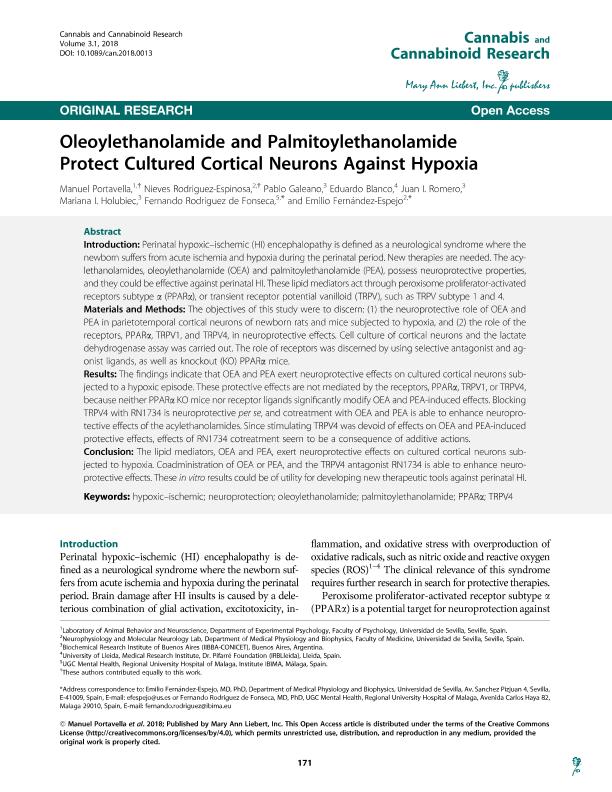Artículo
Oleoylethanolamide and Palmitoylethanolamide Protect Cultured Cortical Neurons Against Hypoxia
Portavella, Manuel; Rodriguez Espinosa, Nieves; Galeano, Pablo ; Blanco, Eduardo; Romero, Juan Ignacio
; Blanco, Eduardo; Romero, Juan Ignacio ; Holubiec, Mariana Ines
; Holubiec, Mariana Ines ; Rodriguez De Fonseca, Fernando; Fernández Espejo, Emilio
; Rodriguez De Fonseca, Fernando; Fernández Espejo, Emilio
 ; Blanco, Eduardo; Romero, Juan Ignacio
; Blanco, Eduardo; Romero, Juan Ignacio ; Holubiec, Mariana Ines
; Holubiec, Mariana Ines ; Rodriguez De Fonseca, Fernando; Fernández Espejo, Emilio
; Rodriguez De Fonseca, Fernando; Fernández Espejo, Emilio
Fecha de publicación:
09/2018
Editorial:
Mary Ann Liebert
Revista:
Cannabis and Cannabinoid Research
ISSN:
2378-8763
Idioma:
Inglés
Tipo de recurso:
Artículo publicado
Clasificación temática:
Resumen
Introduction: Perinatal hypoxic-ischemic (HI) encephalopathy is defined as a neurological syndrome where the newborn suffers from acute ischemia and hypoxia during the perinatal period. New therapies are needed. The acylethanolamides, oleoylethanolamide (OEA) and palmitoylethanolamide (PEA), possess neuroprotective properties, and they could be effective against perinatal HI. These lipid mediators act through peroxisome proliferator-activated receptors subtype α (PPARα), or transient receptor potential vanilloid (TRPV), such as TRPV subtype 1 and 4. Materials and Methods: The objectives of this study were to discern: (1) the neuroprotective role of OEA and PEA in parietotemporal cortical neurons of newborn rats and mice subjected to hypoxia, and (2) the role of the receptors, PPARα, TRPV1, and TRPV4, in neuroprotective effects. Cell culture of cortical neurons and the lactate dehydrogenase assay was carried out. The role of receptors was discerned by using selective antagonist and agonist ligands, as well as knockout (KO) PPARα mice. Results: The findings indicate that OEA and PEA exert neuroprotective effects on cultured cortical neurons subjected to a hypoxic episode. These protective effects are not mediated by the receptors, PPARα, TRPV1, or TRPV4, because neither PPARα KO mice nor receptor ligands significantly modify OEA and PEA-induced effects. Blocking TRPV4 with RN1734 is neuroprotective per se, and cotreatment with OEA and PEA is able to enhance neuroprotective effects of the acylethanolamides. Since stimulating TRPV4 was devoid of effects on OEA and PEA-induced protective effects, effects of RN1734 cotreatment seem to be a consequence of additive actions. Conclusion: The lipid mediators, OEA and PEA, exert neuroprotective effects on cultured cortical neurons subjected to hypoxia. Coadministration of OEA or PEA, and the TRPV4 antagonist RN1734 is able to enhance neuroprotective effects. These in vitro results could be of utility for developing new therapeutic tools against perinatal HI.
Archivos asociados
Licencia
Identificadores
Colecciones
Articulos(IIBBA)
Articulos de INST.DE INVEST.BIOQUIMICAS DE BS.AS(I)
Articulos de INST.DE INVEST.BIOQUIMICAS DE BS.AS(I)
Citación
Portavella, Manuel; Rodriguez Espinosa, Nieves; Galeano, Pablo; Blanco, Eduardo; Romero, Juan Ignacio; et al.; Oleoylethanolamide and Palmitoylethanolamide Protect Cultured Cortical Neurons Against Hypoxia; Mary Ann Liebert; Cannabis and Cannabinoid Research; 3; 1; 9-2018; 171-178
Compartir
Altmétricas



